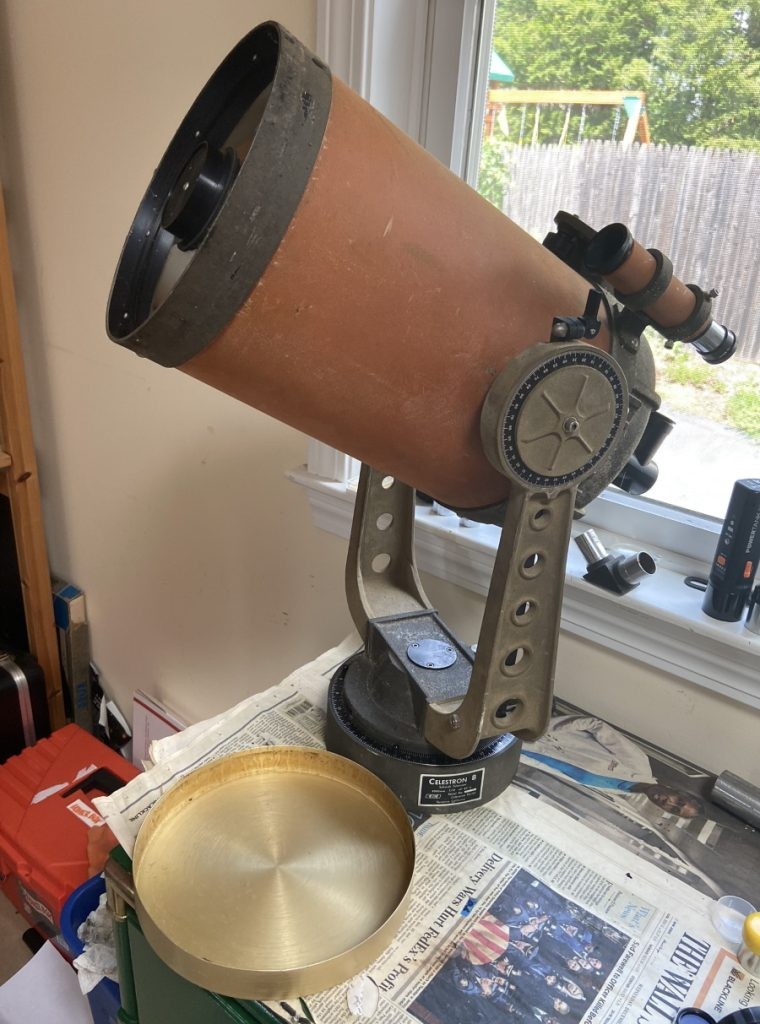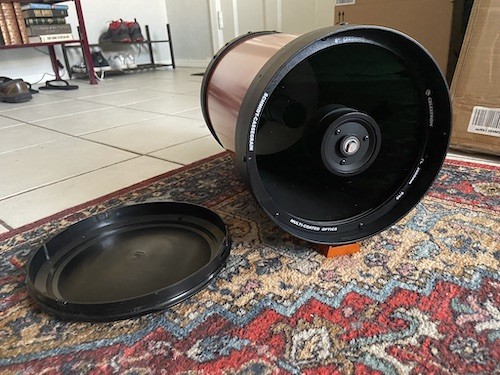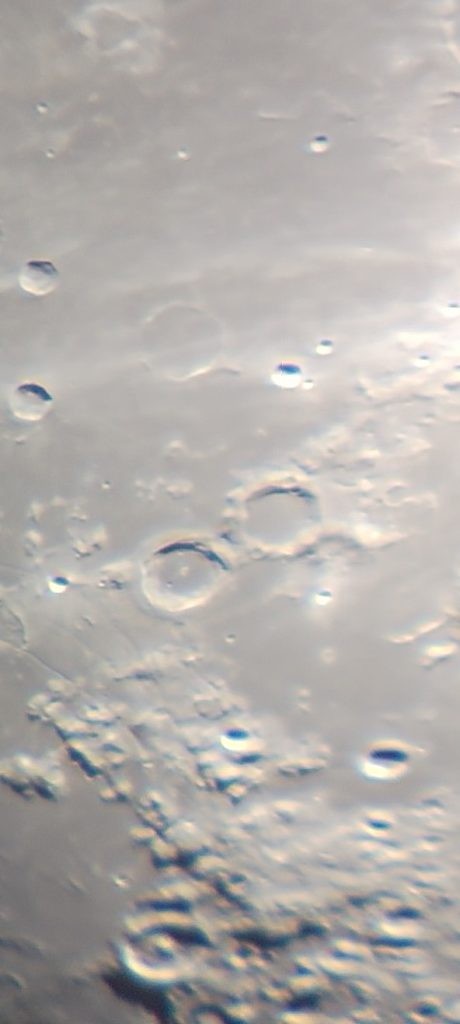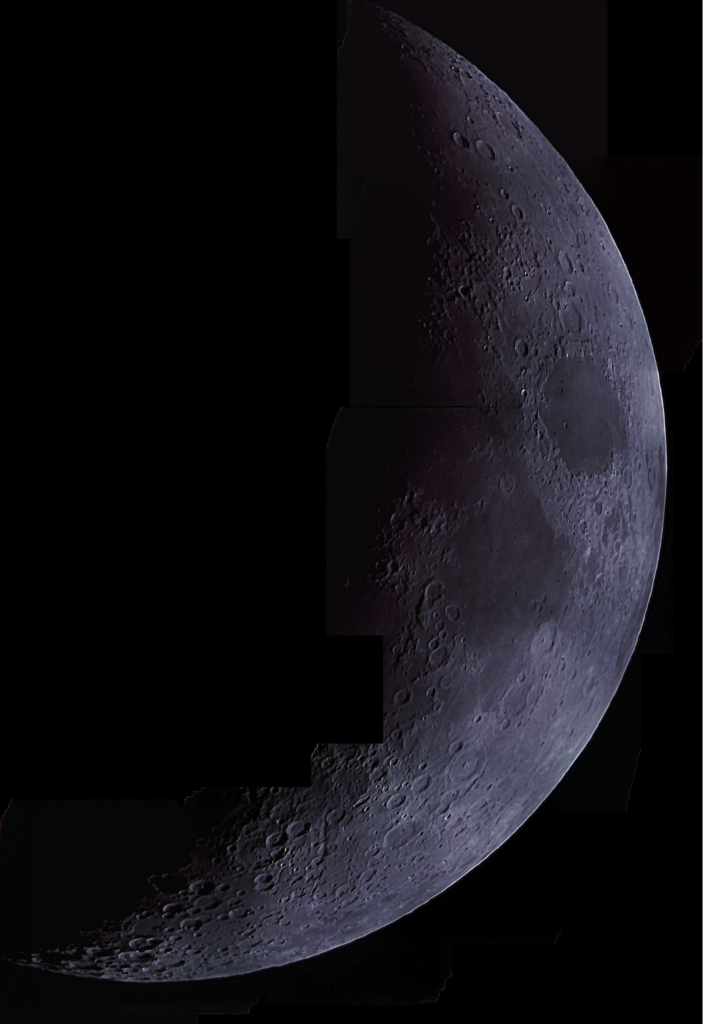
Optics
As a Schmidt-Cassegrain, the C8 utilizes a catadioptric 3-element design with a Schmidt corrector plate at the front, a spherical primary mirror, and a slightly aspheric hand-figured secondary mirror. The 8” (203mm) f/2 primary mirror is “magnified” by about 5x by the secondary mirror’s convex curvature to achieve a system focal length of 2032mm and an f/10 focal ratio.
The Schmidt corrector is not a flat piece of glass as some believe, but a precision, fourth-order curved optical surface made in a special “master block” process; replacing it with flat glass will result in severe spherical and other aberrations. If you break the corrector, the scope’s entire set of optics must be replaced, as the secondary mirror is hand-figured to match a particular corrector’s exact optical prescription.

The StarBright XLT multi-coatings on the newer C8s result in higher light transmission than with older scopes; the scope only loses about 2.6% of the light hitting it to reflections off the corrector and absorption through the mirrors. Supposedly, an older-generation C8 with no corrector coatings and standard mirror coatings loses a massive 27% of the light entering it, and a C8 with regular “Starbright” or “Special Coatings” loses 13%. I would not read too much into these numbers. Even if they are true, the human eye is not very good at detecting the difference at the eyepiece, and while Starbright may make images a little brighter, it is probably not going to make the difference between seeing a faint object or not. Still, it is nice to have.
The optics in most C8s are very sharp. Magnifications of up to 400x are possible on good nights. Deep-sky objects are plenty of fun with 8” of aperture, and you can see a wealth of detail on the Moon and planets. The only major con of this scope is its relatively slow focal ratio of f/10 and resulting narrow field. The maximum field of view you can get without vignetting is about 1.2 degrees using either a wide-field 2” eyepiece or a 1.25” eyepiece with the scope’s f/6.3 reducer. This means some deep-sky objects will not fit in the field. The fully illuminated field of the C8 is slightly smaller than that of the widest field stops found in some 2” eyepieces, so some vignetting is possible with 2” oculars.
Mechanics
Like all Celestron SCTs ever manufactured, the C8 uses a moving-mirror focusing system, with the primary sliding back and forth on a threaded rod. As this configuration is asymmetrical, the primary mirror can flop around while focusing, causing image shift, and over long periods of time while imaging, it can slowly flop, causing mirror flop, which ruins an exposure. Thankfully, with the modern C8 XLT, this problem has been all but banished. If you plan on doing long-exposure astrophotography with the C8, you can add aftermarket mirror locks to solve this or buy the EdgeHD model, which comes with them.
Like all SCTs, the C8 uses standard threads on its back, allowing for the attachment of accessories such as an f/6.3 reducer/corrector, a camera T-adapter, an off-axis guider for autoguiding, a 1.25” or 2” visual back, a 2” thread-on star diagonal, or an external Crayford focuser to fine-tune your focus for astro-imaging and avoid mirror flop.
The C8 XLT requires occasional collimation, which can be done by pointing the telescope at a bright star and adjusting the three screws at the front of the secondary mirror holder. Our collimation guide provides a good overview of the process. The stock Philips head screws at the front of the telescope require a screwdriver to adjust collimation, but they stay secure when tightened. However, thumb screws, while tempting to purchase from third parties, should not be used as they cannot be tightened enough to keep the secondary mirror in place and will cause collimation shift between sessions or even while you use the telescope, which can ruin a night of observing or imaging.
The C8 XLT is offered with either a Vixen or CGE-style dovetail rail attached to the bottom for attaching it to any compatible mount; the Vixen plate fits almost any usable astronomical mount, while the CGE dovetail fits any mount saddle that accepts CGE or Losmandy plates. The CGE dovetail is more rigid for imaging applications. A second dovetail can also be attached to the top of the C8 XLT optical tube to piggyback a guide scope or other accessories.
Accessories
The C8 XLT comes with a 1.25” visual back, 1.25” prism star diagonal, and 25mm E-Lux Plossl eyepiece yielding 81x with an apparent field of view of 52 degrees, translating to a true field of 0.64 degrees, or a bit bigger than the apparent diameter of the full Moon. This eyepiece works fine, but of course you’ll want more. You also get a usable, albeit small, 6×30 finderscope. If you are planning on visual use, a Telrad and/or 9×50 in place of the 6×30 finder would be good, as well as a 2” star diagonal and/or f/6.3 reducer.
Mount Recommendations
You can do deep-sky astrophotography with your C8 on a mount with at least 40 pounds of capacity, like a Celestron CGEM II or CGX, a Sky-Watcher EQ6Ri Pro, an Orion Atlas EQ-G, or a Losmandy G11. We would recommend using an f/6.3 reducer, and you should definitely use autoguiding.
For planetary imaging or purely visual observation, pretty much any steady mount with a drive, be it a NexStar Evolution mount, a clock-driven fork mount, or an EQ5-class equatorial mount, will do the job of holding the C8 XLT.
Should I buy a Used Celestron C8 XLT?
When looking to purchase a used C8 XLT optical tube, or any used Schmidt-Cassegrain or other catadioptric telescope, be sure to check for corrosion on the mirrors and fungus on the front corrector plate, as corrosion and fungus can cause permanent damage. Avoid buying Schmidt-Cassegrain telescopes with broken front corrector plates, as they cannot be repaired or replaced without replacing all the optics which will cost more than what the telescope is worth. Missing accessories are not much of a problem since they are typically inexpensive to replace. Older models of the C8 don’t differ much from new ones apart from lacking HyperStar compatibility and having slightly lower transmission optical coatings; many orange-tubed C8s lack anti-reflection coatings on the corrector altogether which causes a visible but still fairly low amount of light loss compared to the various Starbright and Starbright XLT coatings, which differ from each other in performance by a negligible amount.
Aftermarket Accessory Recommendations
If you want to get the most out of your C8 XLT’s achievable field of view for low-power vistas of deep-sky objects, we highly recommend you get a 2” mirror star diagonal such as Apertura’s dielectric model, which screws directly onto the back of the telescope. The 25mm E-Lux Plossl that comes with the C8 XLT works fine, but using the 2” diagonal will allow you to supplement it with a 2” low-power wide-angle eyepiece like Apertura’s 38mm SWA (53x), which will achieve the widest possible field of view one can get with the C8 XLT (with minor vignetting). Alternatively, Celestron’s f/6.3 reducer coupled with the 25mm E-Lux will achieve a similar true field, and the reducer can be used for deep-sky astrophotography as well.
We also recommend additional shorter focal length eyepieces, such as a mid-range eyepiece between 12-18mm focal length like Explore Scientific’s 14mm 82-degree (145x), and a 10mm or shorter high-power eyepiece like Explore Scientific’s 8.5mm 82-degree (239x). Cheaper alternatives such as SuperView, SWA, and goldline/redline oculars will also do well at the C8 XLT’s slow focal ratio of f/10. If you are planning on using the scope for planetary imaging, then a good Barlow lens may be preferable to a high-power eyepiece and is required to achieve the image scale for good planetary astrophotos.
Lastly, you may wish to get a good UHC filter for viewing nebulae, such as the Orion UltraBlock UHC nebula filter, preferably in a 2” size format so it can be attached to a 1.25” adapter for use with both sizes of eyepieces. This will help improve contrast when viewing nebulae no matter what kind of sky conditions you have. Additionally, it’s essential to buy a dew shield for the C8 XLT as its thin Schmidt corrector plate cools rapidly and is prone to collecting dew quickly if set up in damp conditions; plus, the dew shield helps protect the corrector from bugs and fingerprints, as well as reducing inputs of glare such as moonlight or streetlights that could lessen contrast at the eyepiece.
Astrophotography Capabilities
The Celestron C8 XLT is a great choice for planetary astrophotography and is about the smallest aperture you can get away with and still achieve good results. Using a 2-3x Barlow lens and high-speed planetary video camera such as the ZWO ASI224MC with laptop capture software will allow you to take stunning pictures of the Moon and planets such as Mars, Jupiter, and Saturn.
For deep-sky imaging, however, the C8 XLT’s large size and long focal length necessitate a big mount, and achieving consistently good results can be challenging. Its focal length needs to be reduced to f/6.3 and 1280mm for long exposures; good autoguiding and polar alignment are a must. The EdgeHD version of the C8 XLT is better for imaging due to its flatter and unvignetted field along with the included mirror locks, but the regular C8 XLT works well enough for imaging too. You can also convert the C8 to a 400mm focal length, f/2 Schmidt camera with a Starizona HyperStar kit, though the 8” RASA has this built in and is usually more economical as well as capable if you wish to go down the f/2 route.






What can you see?
The C8 XLT telescope offers a maximum unvignetted field of view of 1.1 degrees when using either a 2” wide-angle ocular or 1.25” eyepiece and f/6.3 reducer, which is quite a bit smaller than the field of view that can be achieved with an 8-10” Dobsonian telescope. Though this limited field size may mean that larger open star clusters and nebulae are not ideal for viewing, many smaller open star clusters, brighter globular star clusters from the Messier catalog, small planetary nebulae like Ghost of Jupiter Nebula or Cat’s Eye Nebula, and larger emission nebulae such as Orion (M42), the Lagoon (M8) and the Swan (M17) can be seen in great detail, especially under dark skies. Under light-polluted skies, galaxies will appear as smudges with any telescope, but if transported to a darker location, the C8 XLT is more than capable of revealing hints of spiral arms, dust lanes, and H-II regions in brighter galaxies from the Messier and NGC catalogs as well as some galaxy groups and various huge galaxy clusters in Virgo, Leo, Fornax, and Coma Berenices.
The Celestron 8″ XLT telescope is capable of amazing views of the Moon and planets. You can easily observe Mercury and Venus in all their phases, as well as subtle features such as dark markings and polar ice caps on Mars when the planet is close to Earth. Jupiter’s cloud belts and various atmospheric details, including the Great Red Spot appear sharp and colorful; its four Galilean moons are of course easy to see. At high power during their frequent transits, the C8 XLT will reveal the disks of all four moons along with their shadows moving across Jupiter’s cloud belts. Saturn is also a great sight in this telescope, with its rings, cloud belts, and several of its moons clearly visible, along with the Cassini Division in the rings on a steady night. Uranus and Neptune appear as tiny greenish and blueish orbs; Uranus’ moons are barely within reach of the C8 XLT’s light-gathering power, while Neptune’s moon Triton is fairly conspicuous next to the ice giant. It is technically possible to observe Pluto with this C8 XLT under dark skies as a star-like point; it will usually be too faint for most observers to spot, however, and a larger telescope has a higher chance of success in revealing the dwarf planet.


